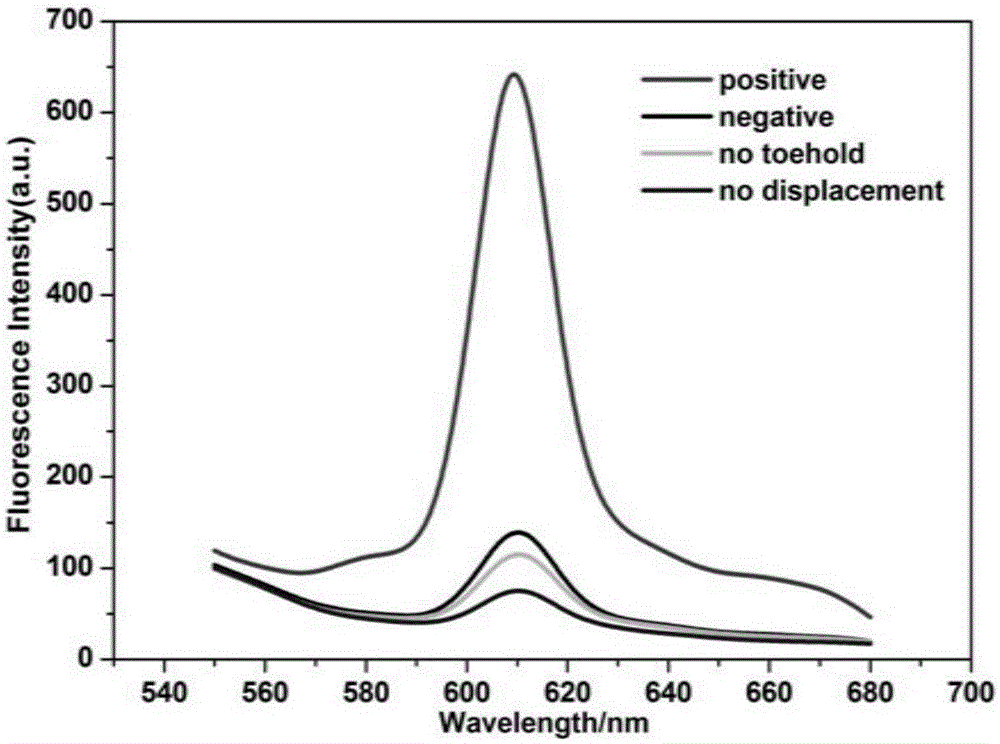High-sensitivity uracil DNA glycosylase (UDG) detection using DNA three-direction section activated hybridization chain reaction
A technology of hybrid chain reaction and glycosylase, which is applied in the field of enzyme activity detection, can solve the problems of lack of recognition mechanism and achieve good specificity and low detection limit
- Summary
- Abstract
- Description
- Claims
- Application Information
AI Technical Summary
Problems solved by technology
Method used
Image
Examples
Embodiment 1
[0040] Embodiment one, experimental method
[0041] UDG and its recognition sequence interaction
[0042] Add the annealed UDG recognition sequence, different concentrations of UDG enzyme, UDG action buffer and ultrapure water into 10 μL reaction system, and react for 45 minutes after vortex mixing.
[0043] Performing a hybridization chain reaction
[0044] After UDG reacts with its recognition sequence, the conformational transition of the hairpin occurs, and the toehold and the chain migration part originally enclosed in the rigid structure of the hairpin get close to form a complete hybridization chain reaction initiation chain. In the above system, add 1×TNaK buffer solution, H1, H2 and ultrapure water, vortex and mix well and react for 2 hours.
[0045] Dye addition and fluorescence measurement
[0046] After the above hybridization chain reaction is completed, add NMM, KCl and ultrapure water to the reaction system to increase its volume to 50 μL. After vortex mixin...
Embodiment 2
[0050] Example 2: Highly sensitive detection of uracil DNA glycosylase by hybridization chain reaction based on DNA three-way joint activation
[0051] The principle of detection of uracil DNA glycosylase activity by hybridization chain reaction based on DNA three-way joint activation
[0052] The invention designs the hairpin remodeling strategy induced by UDG enzyme, and combines the isothermal amplification function of the hybridization chain reaction to carry out specific recognition and high-sensitivity detection. The specific principle is as follows: UDG recognition probe (RUP) is designed, which includes UDG recognition sequence, toehold, strand migration part and two complementary auxiliary sequences. When UDG enzyme is added to the system, the U on the recognition probe is removed to generate an abasic site (APsite), which makes the hybridization of the chain migration part and the UDG recognition sequence extremely unstable. At this time, the complementary auxiliary...
PUM
 Login to View More
Login to View More Abstract
Description
Claims
Application Information
 Login to View More
Login to View More - R&D
- Intellectual Property
- Life Sciences
- Materials
- Tech Scout
- Unparalleled Data Quality
- Higher Quality Content
- 60% Fewer Hallucinations
Browse by: Latest US Patents, China's latest patents, Technical Efficacy Thesaurus, Application Domain, Technology Topic, Popular Technical Reports.
© 2025 PatSnap. All rights reserved.Legal|Privacy policy|Modern Slavery Act Transparency Statement|Sitemap|About US| Contact US: help@patsnap.com



